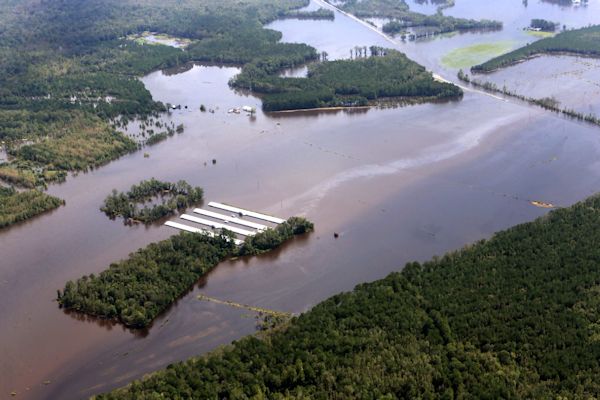SEJournal Online is the digital news magazine of the Society of Environmental Journalists. Learn more about SEJournal Online, including submission, subscription and advertising information.
 |
| Aerial photograph of an animal feeding operation in Dulpin, N.C., on Sept. 17, flooded in the wake of Hurricane Florence. Such facilities are found throughout the United States and face increased risk from flooding due to extreme weather. Photo: Rick Dove, Waterkeeper Alliance. Click to enlarge. |
TipSheet: Florence Hints at More Flood-induced Animal Waste Spills Across U.S.
As the floodwaters from Hurricane Florence recede, it has become obvious how bad the pollution is from overflowing hog waste lagoons (may require subscription) in the Carolinas. Thing is, similar environmental stories could be found almost anywhere.
The Southeast part of North Carolina is home to an especially dense concentration of hog feeding operations (may require subscription), and the worst rains from Florence were concentrated in just that area. Of course. But concentrated or confined animal feeding operations, or CAFOs, exist for hogs, chickens, turkeys and cattle in many parts of the country, and eventually they will get rained on. Heavily.
This problem got attention — in the same part of the Carolinas — following Hurricane Floyd in 1999. It was ugly (may require subscription). In an effort to lessen the problem, the U.S. Environmental Protection Agency for the first time worked up rules for such CAFO discharges under the Clean Water Act permit program in 2003.
Farmers do not like regulations — but neither do they like their animal waste to pollute. The CAFO water permit rules include much leeway. Small operations have less strict requirements, while the biggest face tougher requirements. And almost all of the time, the permit program is run by state agencies, which often tend to be more accommodating.
The point is that most CAFOs today have (or are supposed to have) measures for preventing spillage of animal waste. Typically, animal waste goes into lagoons where it is digested by bacteria and eventually spread on fields for fertilizer.
Extreme weather worsens pollution risk
Recent EPA compliance reports, among other data, suggest things have gotten better since 1999.
The problem, Hurricane Florence suggests, is that as climate change brings more extreme weather events, things may still get worse. At the same time, Florence may help revive the story.
This is not a challenge limited to the Carolinas. There are lots of hog feeding operations, for example, in Iowa. Once you start looking at poultry and cattle feeding lots, you are talking about much of the United States.
Another thing to realize when you are covering
CAFO pollution is that very often their neighbors
are the powerless and disenfranchised rural poor.
The first and loudest complaints you will hear will probably be about odor. Neighbors do not like the stink that wafts their way when the wind is wrong. While there are some weak federal rules about air pollution from CAFOs, odor itself is largely regulated under state law, if it is regulated at all.
But CAFOs can produce water pollution. One major component is nutrients, the nitrogen and phosphorus that fertilize algae growth in lakes and streams and may ultimately kill fish from lack of oxygen. Another is pathogens, the disease-causing bacteria and viruses that can make people sick when they drink or swim in water.
Another thing to realize when you are covering CAFO pollution is that very often their neighbors are the powerless and disenfranchised rural poor. They do not always live in incorporated towns. Animal feeding operations, and often the processing plants associated with them and the living facilities for workers (and the water they drink), constitute a widespread environmental justice issue.
Tracking down your area CAFO
Whether or not your state agency is regulating CAFOs strictly enough may depend on whether you are asking a farmer or a downstream/downwind neighbor. You may find local activists know a lot.
There are a number of ways to find CAFOs in your area. None is foolproof, so check your facts and use your eyes (and nose).
The advocacy group Food & Water Watch has done a nationwide map that is scalable, and it may be especially good for giving you an overall impression of what is going on in your area. The Environmental Working Group has done a North Carolina map.
You could also search through EPA Clean Water Act permits under the National Pollutant Discharge Elimination System, or NPDES. EPA has a Permit Compliance System searchable database online, which can be sketchy. You have to search on the NAICS industrial category for the type of CAFO you want, which you can look up here. Most of the categories you want begin with 112.
If the EPA database fails you, try your state regulatory agency.
Another good source may be your local Waterkeeper group, part of the Waterkeeper Alliance of watershed protectors. Find your local group here.
You will also want to check in with various agricultural groups, who have a viewpoint but know a lot. Look for local or state affiliates of national groups like the National Pork Producers Council, the United Poultry Growers Association (also see this list of poultry-related groups), the National Cattlemen’s Beef Association or the American Farm Bureau Federation.
* From the weekly news magazine SEJournal Online, Vol. 3, No. 34. Content from each new issue of SEJournal Online is available to the public via the SEJournal Online main page. Subscribe to the e-newsletter here. And see past issues of the SEJournal archived here.













 Advertisement
Advertisement 



